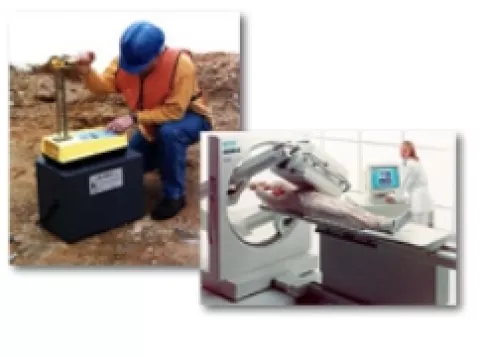Comparison of Conventional Mill, Heap Leach, and In Situ Recovery Facilities
Through the years, the U.S. Nuclear Regulatory Commission (NRC) has licensed numerous uranium recovery facilities in the United States, which used a variety of extraction methods to glean uranium from ore. The following table compares the features of the three main types of facilities, which include conventional uranium mills, heap leach/ion-exchange facilities, and in situ recovery facilities.
| Feature | Conventional Uranium Mill |
Heap Leach Facility | In Situ Recovery Facility |
|---|---|---|---|
| Recovery Method | Physical and chemical process to extract uranium from mined ore. | Physical and chemical process to extract uranium from mined ore that has been piled in a heap. | Chemical process to extract uranium from underground deposits. |
| Siting/Location | Generally located in the vicinity of the ore body. Mined ore can be trucked from the mine to the mill. The mine can be either a deep underground shaft or a shallow open pit. The NRC does not regulate the mining of ore. | Generally located in the vicinity of the ore body. Mined ore can be trucked from the mine to the mill. The mine can be either a deep underground shaft or a shallow open pit. The NRC does not regulate the mining of ore. | The wellfield area is located within the ore body. The processing plant is typically in the vicinity of the ore body. |
| Surface Features | Mill building(s), process tanks, tailings impoundment, and evaporation ponds | Process buildings, heap pile consisting of ore crushed to a size of approximately 1-inch in diameter, with an engineered liner system beneath the heap pile and liquid application on top of the pile | Wellfield(s) consisting of groundwater injection and extraction wells, header house(s), pipes, processing facility, storage or evaporation pond(s), and deep injection wells for liquid waste |
| Approximate Size | Impoundments are limited to 40 acres in size; however, a facility can have multiple impoundments and typically total on the order of hundreds of acres | Heap piles are limited to 40 acres in size; however, a facility can have multiple piles and typically total on the order of hundreds of acres | Thousands of acres |
| Wastes Generated | Mill tailings, a sandy material left over from the crushing process, disposed of within an impoundment; pipes, pumps, and other process equipment that cannot be decontaminated | Heap pile remains in place after processing; pipes, pumps, and other process equipment that cannot be decontaminated | Liquid waste, which is disposed of in a deep disposal well or through an evaporation system; pipes, pumps, and other process equipment that cannot be decontaminated are sent to an NRC-licensed facility for permanent disposal |
| Decommissioning | Demolition of mill and site buildings, final cover system installed over tailings pile, groundwater monitoring | Demolition of site buildings, final cover system installed over heap pile, groundwater monitoring | Restoration of groundwater, decommissioning of injection wells, removal of pipes and processing building |
| Status at End Use | Site permanently transferred to U.S. Department of Energy (DOE) for long-term care; annual inspections performed | Site permanently transferred to DOE for long-term care; annual inspections performed | Site released for unrestricted use when cleanup criteria are met |
Page Last Reviewed/Updated Wednesday, December 02, 2020
Page Last Reviewed/Updated Wednesday, December 02, 2020


